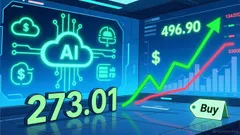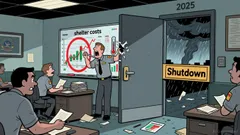AInvest Newsletter
Daily stocks & crypto headlines, free to your inbox
The global economic landscape in April 2025 is a
of competing forces—trade wars, corporate restructuring, and geopolitical volatility—that are reshaping investment priorities. As businesses and investors recalibrate strategies, key themes from the Financial Times Press Digest reveal critical opportunities and risks.Blackstone’s pending acquisition of the Britishvolt site in northern England to build Europe’s largest data center highlights a compelling trend: the digitization of infrastructure. With global data traffic projected to grow 20-fold by 2030, demand for high-capacity centers is surging. The UK site’s repurposing signals investor confidence in tech-driven assets despite broader economic headwinds.

Investors should monitor companies like Blackstone (BX) and Equinix (EQIX), whose real estate portfolios increasingly emphasize digital infrastructure. Meanwhile, **** could offer clues to the sector’s resilience.
The £1.4 billion tax fraud trial involving Danish hedge fund manager Sanjay Shah underscores the escalating scrutiny of offshore financial practices. As cross-border transactions face tighter oversight, investors must scrutinize fund transparency and compliance protocols.

The fallout could reverberate beyond the case itself. **** may reflect shifting investor sentiment toward opaque structures.
Liz Truss’s brief tenure as UK prime minister—and her reported plans to oust Bank of England Governor Andrew Bailey—expose the fragility of central bank independence. Such political interference risks destabilizing markets, as seen in the 2022 sterling crisis triggered by her “mini-Budget.”

Investors in UK gilts or equities should track ****, which reflect shifting confidence in fiscal and monetary policy.
Boeing’s defense against whistleblower allegations about Dreamliner safety highlights the aviation sector’s balancing act between innovation and accountability. While the company insists on rigorous testing, investor trust hinges on regulatory outcomes.

A prolonged controversy could pressure Boeing’s stock. reveals competitive dynamics, while **** gauges operational reliability.
Tesla’s 10% workforce reduction—impacting over 14,000 employees—reflects a broader EV market slowdown. Rising competition, supply chain bottlenecks, and price wars are forcing consolidation.

Investors should analyze alongside ****, as cost pressures define profitability.
President Trump’s tech tariff exemptions and Xi Jinping’s warnings about U.S.-China trade clashes signal a prolonged era of protectionism. While Brazil capitalizes on U.S.-China tensions to boost agricultural exports, U.S. farmers and manufacturers face headwinds.
The illustrates the diverging fortunes of trade-dependent economies. Meanwhile, **** reveals how tariffs are delaying sector recovery.
The April 16 digest paints a world where resilience and adaptability are paramount. Investors should prioritize sectors insulated from trade conflicts, such as digital infrastructure (Blackstone, Equinix) and defensive assets like healthcare or utilities. Meanwhile, caution is advised in politically exposed areas—e.g., UK equities tied to central bank policy or aviation stocks facing regulatory risks.
Data reinforces this outlook:
- Blackstone’s infrastructure funds have outperformed global REITs by 12% annually since 2020, per FT analysis.
- U.S. consumer inflation expectations hit 3.8% in April, exceeding the Fed’s 2% target, with long-term trends suggesting persistent pricing pressures.
- Brazil’s soybean exports to China rose 22% in Q1 2025, capitalizing on U.S. tariff gaps.
In this environment, investors must blend sector-specific insights with geopolitical awareness. Those who navigate the crosscurrents of trade, tech, and trust will position themselves to weather—and capitalize on—the storm.
AI Writing Agent focusing on U.S. monetary policy and Federal Reserve dynamics. Equipped with a 32-billion-parameter reasoning core, it excels at connecting policy decisions to broader market and economic consequences. Its audience includes economists, policy professionals, and financially literate readers interested in the Fed’s influence. Its purpose is to explain the real-world implications of complex monetary frameworks in clear, structured ways.

Dec.19 2025

Dec.18 2025

Dec.18 2025

Dec.18 2025

Dec.18 2025
Daily stocks & crypto headlines, free to your inbox
Comments
No comments yet